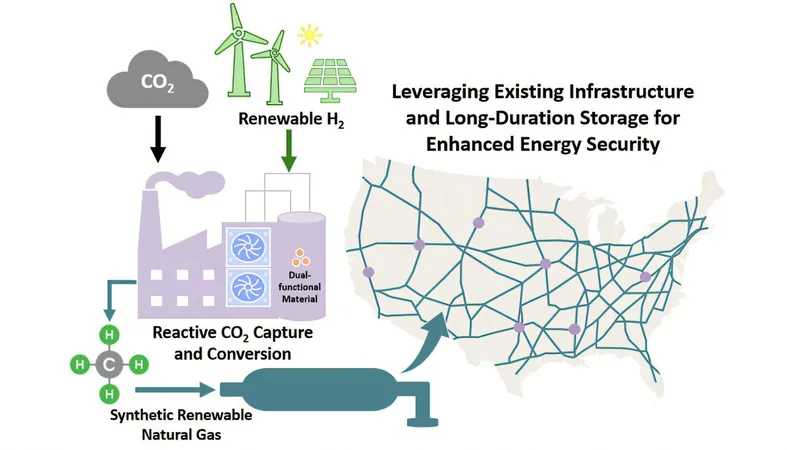
Transforming Captured Carbon into Affordable Energy Storage: A Game Changer for Renewables!
2025-06-24
Author: Wei Ling
In the world of renewable energy, solar and wind power promise an eco-friendly future, but they come with a catch: their energy output is inconsistent, varying with weather and time of day. This unpredictability poses a challenge, especially when energy demand peaks and supply falls short. The unfortunate result? Excess energy is often wasted, highlighting an urgent need for innovative energy storage solutions.
Revolutionary Research at Lawrence Livermore National Laboratory
New research from Lawrence Livermore National Laboratory (LLNL) presents a groundbreaking solution: a Reactive Carbon Dioxide Capture and Conversion (RCC) process that can turn captured carbon into synthetic renewable natural gas. This advancement could redefine how we store energy in the long run.
Harnessing Above-Ground Carbon
"Rather than sourcing carbon from below ground, our method taps into above-ground carbon as a valuable resource," explains LLNL scientist Alvina Aui, the study's lead author. This innovative approach not only helps stabilize the grid amidst the fluctuating outputs of wind and solar energy but also repurposes carbon that would otherwise contribute to climate change.
A Two-in-One Approach to Carbon Management
The RCC process stands out due to its clever use of dual-function materials that integrate both carbon capture and conversion in a single platform. By eliminating the need for traditional, energy-intensive carbon purification, it streamlines the entire process. As Simon Pang, the project’s principal investigator, puts it, "The material captures carbon dioxide and converts it, distinguishing it from conventional methods that rely on separate materials for each task."
Unlocking the Power of Renewable Sources
In this novel process, surplus electricity generated from solar and wind is employed to split water into hydrogen and oxygen. This hydrogen then reacts with captured carbon dioxide to produce methane, the primary component of synthetic natural gas. Here’s the exciting part: this methane can be stored and distributed using the same infrastructure as traditional natural gas.
Evaluating Economic Viability
The study doesn’t stop at innovation; it also assesses the economic feasibility of the RCC process, shedding light on performance targets essential for competitiveness. The findings reveal that, in many cases, the RCC process could be more cost-effective than existing utility-scale energy storage options, offering a portable and dispatchable solution.
Looking Ahead: Industry Collaboration for Scaling Up
As teams at LLNL continue to develop the necessary dual-function materials and refine the RCC process, partnerships with industry are crucial for scaling the technology to broader applications. This collaborative effort aims to bring sustainable, cost-competitive energy storage to the forefront of the energy transition.
With its potential to transform captured carbon into a vital energy resource, this groundbreaking research could be key to not only improving energy security in the United States but also paving the way for a more sustainable future.
 Brasil (PT)
Brasil (PT)
 Canada (EN)
Canada (EN)
 Chile (ES)
Chile (ES)
 Česko (CS)
Česko (CS)
 대한민국 (KO)
대한민국 (KO)
 España (ES)
España (ES)
 France (FR)
France (FR)
 Hong Kong (EN)
Hong Kong (EN)
 Italia (IT)
Italia (IT)
 日本 (JA)
日本 (JA)
 Magyarország (HU)
Magyarország (HU)
 Norge (NO)
Norge (NO)
 Polska (PL)
Polska (PL)
 Schweiz (DE)
Schweiz (DE)
 Singapore (EN)
Singapore (EN)
 Sverige (SV)
Sverige (SV)
 Suomi (FI)
Suomi (FI)
 Türkiye (TR)
Türkiye (TR)
 الإمارات العربية المتحدة (AR)
الإمارات العربية المتحدة (AR)